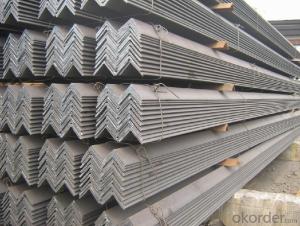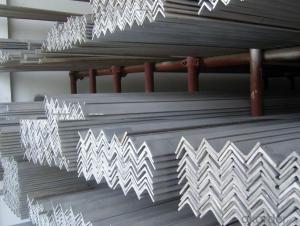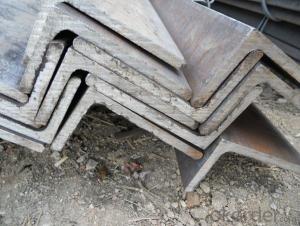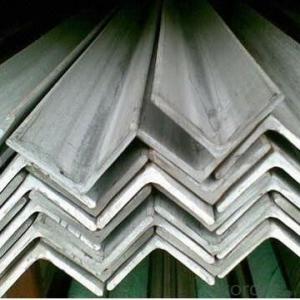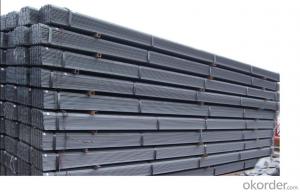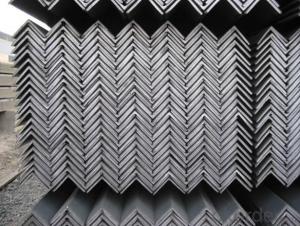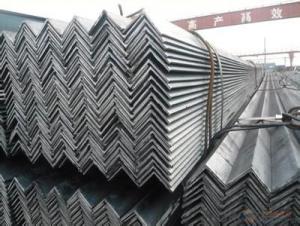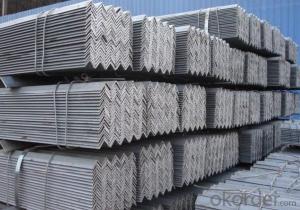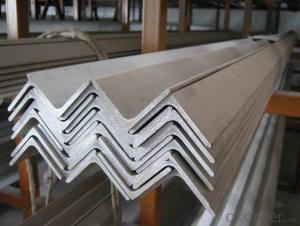Angle steel hot rolled high qulity ASTM A36 GB Q235B
- Loading Port:
- Tianjin
- Payment Terms:
- TT OR LC
- Min Order Qty:
- 50 m.t.
- Supply Capability:
- 200000 m.t./month
OKorder Service Pledge
OKorder Financial Service
You Might Also Like
Angle Steel Details:
| Minimum Order Quantity: | 25mtons | Unit: | m.t. | Loading Port: | China Main Port |
| Supply Ability: | 80000-100000MTS/YEAR | Payment Terms: | TT or LC |
Product Description:
Specifications of Angle Steel
1. Invoicing on theoretical weight or actual weight as customer request
2. Length: 6m, 9m, 12m as following table
3. Sizes

Sizes: 25mm-250mm | ||
a*t | ||
25*2.5-4.0 | 70*6.0-9.0 | 130*9.0-15 |
30*2.5-6.6 | 75*6.0-9.0 | 140*10-14 |
36*3.0-5.0 | 80*5.0-10 | 150*10-20 |
38*2.3-6.0 | 90*7.0-10 | 160*10-16 |
40*3.0-5.0 | 100*6.0-12 | 175*12-15 |
45*4.0-6.0 | 110*8.0-10 | 180*12-18 |
50*4.0-6.0 | 120*6.0-15 | 200*14-25 |
60*4.0-8.0 | 125*8.0-14 | 250*25 |
5. Payment terms:
1).100% irrevocable L/C at sight.
2).30% T/T prepaid and the balance against the copy of B/L.
3).30% T/T prepaid and the balance against L/C
6.Material details:
Alloy No | Grade | Element (%) | |||||
C | Mn | S | P | Si | |||
|
|
|
|
|
|
| |
Q235 | B | 0.12—0.20 | 0.3—0.7 | ≤0.045 | ≤0.045 | ≤0.3 | |
|
|
|
|
|
|
| |
Alloy No | Grade | Yielding strength point( Mpa) | |||||
Thickness (mm) | |||||||
≤16 | >16--40 | >40--60 | >60--100 | ||||
≥ | |||||||
|
|
|
|
|
| ||
Q235 | B | 235 | 225 | 215 | 205 | ||
Alloy No | Grade | Tensile strength (Mpa) | Elongation after fracture (%) | ||||
Thickness (mm) | |||||||
| ≤16 | >16--40 | >40--60 | >60--100 | |||
≥ | |||||||
|
|
|
|
|
|
| |
Q235 | B | 375--500 | 26 | 25 | 24 | 23 | |
Usage & Applications of Angle Steel
According to the needs of different structures, Angle can compose to different force support component, and also can be the connections between components. It is widely used in various building structures and engineering structures such as roof beams, bridges, transmission towers, hoisting machinery and transport machinery, ships, industrial furnaces, reaction tower, container frame and warehouse etc.
Packaging & Delivery of Angle Steel
1. Packing: it is nude packed in bundles by steel wire rod
2. Bundle weight: not more than 3.5MT for bulk vessel; less than 3 MT for container load
3. Marks:
Color marking: There will be color marking on both end of the bundle for the cargo delivered by bulk vessel. That makes it easily to distinguish at the destination port.
Tag mark: there will be tag mark tied up on the bundles. The information usually including supplier logo and name, product name, made in China, shipping marks and other information request by the customer.
If loading by container the marking is not needed, but we will prepare it as customer request.
Production flow of Angle Steel
Material prepare (billet) —heat up—rough rolling—precision rolling—cooling—packing—storage and transportation
- Q: What is the maximum allowable torsional buckling stress for a steel angle?
- The maximum allowable torsional buckling stress for a steel angle depends on various factors such as the material properties, angle dimensions, and the specific design code or standard being followed. Therefore, without specific information, it is not possible to provide a definitive answer. It is recommended to consult the relevant design code or a structural engineer to determine the maximum allowable torsional buckling stress for a steel angle.
- Q: Are steel angles suitable for constructing bridges?
- Indeed, bridges can be constructed using steel angles. Due to their strength and versatility, steel angles are frequently employed in bridge construction. They can easily be fashioned into different forms and dimensions, making them well-suited for crafting structural elements like beams, columns, and trusses. Moreover, steel angles possess exceptional tensile strength, enabling them to endure the weighty loads and forces endured by bridges. Furthermore, steel angles boast excellent resistance to corrosion, guaranteeing the endurance and resilience of bridge structures. In summary, steel angles represent a dependable and economical option for bridge construction.
- Q: How to determine the neutral axis of the angle bar?
- The neutral axis of angle iron or channel steel needs to be calculated, but it can be checked directly.
- Q: How do you determine the appropriate size of steel angle for a specific application?
- To determine the appropriate size of steel angle for a specific application, factors such as the load it needs to bear, the length of the span, the type of material being supported, and any applicable building codes or regulations should be considered. Structural engineers or professionals with expertise in steel construction can perform calculations and analysis to determine the required size of steel angle based on these factors.
- Q: How do steel angles perform in extreme weather conditions?
- Steel angles are highly durable and resistant to extreme weather conditions. They can withstand high winds, heavy rains, and temperature fluctuations without losing their structural integrity. Their strength and stability make them an excellent choice for construction projects in areas prone to hurricanes, tornadoes, or harsh climates.
- Q: Can steel angles be used for supports in construction?
- Yes, steel angles can be used for supports in construction. Steel angles are commonly used in construction projects as structural supports due to their strength and versatility. They can be used in various applications such as supporting beams, columns, and frames. Steel angles provide stability and rigidity to the structure, making them suitable for supporting heavy loads and withstanding forces such as gravity and wind. Additionally, they can be easily welded or bolted together, allowing for quick and efficient installation. Overall, steel angles are a popular choice for construction supports due to their durability, strength, and ease of use.
- Q: What are the different welding methods used for steel angles?
- There are several different welding methods that can be used for steel angles. The choice of method depends on various factors including the thickness of the steel, the type of joint, and the desired outcome. Here are some of the commonly used welding methods for steel angles: 1. Shielded Metal Arc Welding (SMAW): Also known as stick welding, SMAW uses a consumable electrode coated in flux. The electrode is manually fed into the joint, and the flux creates a protective shield around the weld pool. SMAW is versatile and can be used for various joint configurations and thicknesses. 2. Gas Metal Arc Welding (GMAW): Commonly referred to as MIG (Metal Inert Gas) or MAG (Metal Active Gas) welding, GMAW uses a wire electrode that is continuously fed through a welding gun. The electrode melts and joins the steel angles together, while a shielding gas (either inert or active) protects the weld pool. GMAW is fast and suitable for thin to medium thickness steel angles. 3. Flux-Cored Arc Welding (FCAW): Similar to GMAW, FCAW uses a continuously fed wire electrode. However, the electrode is filled with flux, eliminating the need for an external shielding gas. FCAW is versatile, easy to use, and can be employed in various positions. It is commonly used for thicker steel angles and in outdoor applications where wind might affect gas shielding. 4. Gas Tungsten Arc Welding (GTAW): Also known as TIG (Tungsten Inert Gas) welding, GTAW uses a non-consumable tungsten electrode to create an arc. A separate filler metal is manually added to the joint, while a shielding gas protects the weld pool. GTAW produces high-quality, precise welds and is commonly used for thinner steel angles or when aesthetics are important. 5. Submerged Arc Welding (SAW): This method involves feeding a continuously fed wire electrode into the joint while simultaneously covering the weld area with a layer of granular flux. The flux acts as a protective medium and prevents atmospheric contamination. SAW is commonly used for thicker steel angles and in applications where high deposition rates are required. These are just a few of the welding methods commonly used for steel angles. Each method has its advantages and limitations, and the choice of method should be based on the specific requirements of the project. It is important to consult with a qualified welding professional to determine the most suitable method for a particular application.
- Q: What are the different types of connections used with steel angles?
- There are several different types of connections used with steel angles, depending on the specific needs and requirements of the structure. Some of the most common types of connections include: 1. Welded Connection: This is one of the most popular types of connections used with steel angles. It involves welding the angle to another steel member, such as a beam or column, using various welding techniques. Welded connections provide excellent strength and stability. 2. Bolted Connection: Bolted connections involve using bolts and nuts to secure the steel angle to another component. This type of connection allows for easy disassembly and offers flexibility in adjusting or replacing components. Bolted connections are often used when there is a need for future modifications or repairs. 3. Riveted Connection: Riveted connections were widely used in the past but are less common today. They involve using rivets to connect the steel angle to other components. Riveted connections provide high strength and durability, but they require specialized skills and equipment for installation. 4. Gusset Plate Connection: In some cases, a gusset plate is used to connect steel angles. A gusset plate is a flat plate that is typically bolted or welded to the angle and the other component, providing additional strength and stability. 5. Moment Connection: A moment connection is a specialized type of connection used to transfer bending moments between steel angles and other components, such as beams or columns. Moment connections are designed to handle significant loads and provide enhanced structural integrity. Overall, the choice of connection type depends on factors such as load requirements, structural design, ease of installation, and potential for future modifications. Each type of connection has its own advantages and limitations, and the appropriate connection type is determined by a structural engineer based on the specific project requirements.
- Q: What is the lifespan of steel angles?
- The durability and longevity of steel angles can be influenced by several factors, including the quality of the steel, the environmental conditions in which they are used, and the level of maintenance they receive. It is widely recognized that steel angles are highly durable and long-lasting, which is why they are commonly chosen for construction and structural purposes. When high-quality steel angles are manufactured and maintained properly, they can endure for several decades or even longer. However, their lifespan can be significantly reduced by factors such as exposure to harsh weather, corrosive environments, and neglectful maintenance. To ensure the maximum lifespan of steel angles, it is crucial to select the appropriate steel grade for the specific application, carry out proper installation, and regularly inspect and maintain them. This may involve actions such as periodically applying paint or protective coatings to prevent corrosion, conducting routine inspections to detect any signs of wear or damage, and promptly addressing any issues that arise. In conclusion, the lifespan of steel angles can vary, but with adequate care and maintenance, they can last for many years, providing strength and stability to a wide range of structures and applications.
- Q: What is the difference between hot-rolled and cold-rolled steel angles?
- Hot-rolled and cold-rolled steel angles refer to two different manufacturing processes used to create steel angles with varying characteristics. Hot-rolled steel angles are produced by heating a steel billet or ingot to a high temperature and then passing it through a series of rollers. This process allows for the metal to be shaped and formed while it is still in a malleable and pliable state. As a result, hot-rolled steel angles tend to have a rougher surface finish and less precise dimensions compared to cold-rolled angles. However, they are generally stronger and more durable, making them suitable for structural applications that require high strength and load-bearing capacity. On the other hand, cold-rolled steel angles are created by passing hot-rolled steel through a series of rollers at room temperature. This process not only helps to refine the dimensions and surface finish of the steel angles but also increases their strength and hardness. Cold-rolled angles have a smoother surface finish and more accurate dimensions, which makes them ideal for applications that require a precise fit or a smoother appearance. They are commonly used in architectural and decorative applications, as well as in industries where aesthetics and precision are important. In summary, the main differences between hot-rolled and cold-rolled steel angles lie in their manufacturing processes, surface finish, dimensional accuracy, and applications. Hot-rolled angles are stronger and rougher, suitable for structural purposes, while cold-rolled angles have a smoother finish and precise dimensions, making them more suitable for decorative and architectural applications.
Send your message to us
Angle steel hot rolled high qulity ASTM A36 GB Q235B
- Loading Port:
- Tianjin
- Payment Terms:
- TT OR LC
- Min Order Qty:
- 50 m.t.
- Supply Capability:
- 200000 m.t./month
OKorder Service Pledge
OKorder Financial Service
Similar products
Hot products
Hot Searches
Related keywords
